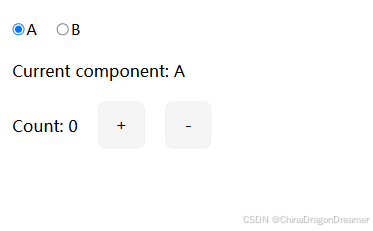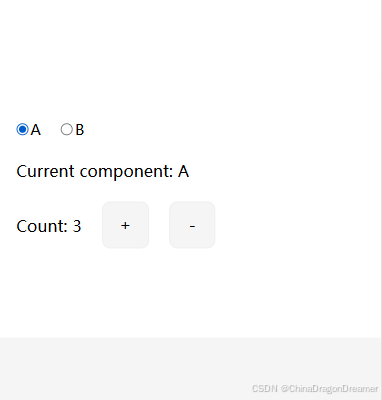一、内置特殊元素
不是组件
<component>、<slot> 和 <template> 具有类似组件的特性,也是模板语法的一部分。但它们并非真正的组件,同时在模板编译期间会被编译掉。因此,它们通常在模板中用小写字母书写。
1.1 <component>
一个用于渲染动态组件或元素的“元组件”。
1.1.1 Props
interface DynamicComponentProps {
is: string | Component
}
1.1.2 详细信息
要渲染的实际组件由 is prop 决定。
- 当 is 是字符串,它既可以是 HTML 标签名也可以是组件的注册名。
- 或者,is 也可以直接绑定到组件的定义。
示例
按注册名渲染组件 (选项式 API):
<script>
import Foo from './Foo.vue'
import Bar from './Bar.vue'
export default {
components: { Foo, Bar },
data() {
return {
view: 'Foo'
}
}
}
</script>
<template>
<component :is="view" />
</template>
按定义渲染组件 (<script setup> 组合式 API):
<script setup>
import Foo from './Foo.vue'
import Bar from './Bar.vue'
</script>
<template>
<component :is="Math.random() > 0.5 ? Foo : Bar" />
</template>
渲染 HTML 元素:
<component :is="href ? 'a' : 'span'"></component>
内置组件都可以传递给 is,但是如果想通过名称传递则必须先对其进行注册。举例来说:
<script>
import { Transition, TransitionGroup } from 'vue'
export default {
components: {
Transition,
TransitionGroup
}
}
</script>
<template>
<component :is="isGroup ? 'TransitionGroup' : 'Transition'">
...
</component>
</template>
如果将组件本身传递给 is 而不是其名称,则不需要注册,例如在 <script setup> 中。
如果在 <component> 标签上使用 v-model,模板编译器会将其扩展为 modelValue prop 和 update:modelValue 事件监听器,就像对任何其他组件一样。但是,这与原生 HTML 元素不兼容,例如 <input> 或 <select>。因此,在动态创建的原生元素上使用 v-model 将不起作用:
<script setup>
import { ref } from 'vue'
const tag = ref('input')
const username = ref('')
</script>
<template>
<!-- 由于 'input' 是原生 HTML 元素,因此这个 v-model 不起作用 -->
<component :is="tag" v-model="username" />
</template>
在实践中,这种极端情况并不常见,因为原生表单字段通常包裹在实际应用的组件中。如果确实需要直接使用原生元素,那么你可以手动将 v-model 拆分为 attribute 和事件。
二、动态组件
有些场景会需要在两个组件间来回切换,比如 Tab 界面:
通过 Vue 的 元素和特殊的 is attribute 实现的:
<!-- currentTab 改变时组件也改变 -->
<component :is="tabs[currentTab]"></component>
被传给 :is 的值可以是以下几种:
- 被注册的组件名
- 导入的组件对象
可以使用 is attribute 来创建一般的 HTML 元素。
当使用 <component :is=“…”> 来在多个组件间作切换时,被切换掉的组件会被卸载。我们可以通过 <KeepAlive> 组件强制被切换掉的组件仍然保持“存活”的状态。
三、KeepAlive
<KeepAlive> 是一个内置组件,它的功能是在多个组件间动态切换时缓存被移除的组件实例。
3.1 基本使用
在组件基础章节中,我们已经介绍了通过特殊的 <component> 元素来实现动态组件的用法:
<component :is="activeComponent" />
默认情况下,一个组件实例在被替换掉后会被销毁。这会导致它丢失其中所有已变化的状态——当这个组件再一次被显示时,会创建一个只带有初始状态的新实例。
在下面的例子中,你会看到两个有状态的组件——A 有一个计数器,而 B 有一个通过 v-model 同步 input 框输入内容的文字展示。尝试先更改一下任意一个组件的状态,然后切走,再切回来:
你会发现在切回来之后,之前已更改的状态都被重置了。
在切换时创建新的组件实例通常是有意义的,但在这个例子中,我们的确想要组件能在被“切走”的时候保留它们的状态。要解决这个问题,我们可以用 <KeepAlive> 内置组件将这些动态组件包装起来:
<!-- 非活跃的组件将会被缓存! -->
<KeepAlive>
<component :is="activeComponent" />
</KeepAlive>
3.2 包含/排除
<KeepAlive> 默认会缓存内部的所有组件实例,但我们可以通过 include 和 exclude prop 来定制该行为。这两个 prop 的值都可以是一个以英文逗号分隔的字符串、一个正则表达式,或是包含这两种类型的一个数组:
<!-- 以英文逗号分隔的字符串 -->
<KeepAlive include="a,b">
<component :is="view" />
</KeepAlive>
<!-- 正则表达式 (需使用 `v-bind`) -->
<KeepAlive :include="/a|b/">
<component :is="view" />
</KeepAlive>
<!-- 数组 (需使用 `v-bind`) -->
<KeepAlive :include="['a', 'b']">
<component :is="view" />
</KeepAlive>
它会根据组件的 name 选项进行匹配,所以组件如果想要条件性地被 KeepAlive 缓存,就必须显式声明一个 name 选项。
注意
在 3.2.34 或以上的版本中,使用 <script setup> 的单文件组件会自动根据文件名生成对应的 name 选项,无需再手动声明。
3.3 最大缓存实例数
我们可以通过传入 max prop 来限制可被缓存的最大组件实例数。<KeepAlive> 的行为在指定了 max 后类似一个 LRU 缓存:如果缓存的实例数量即将超过指定的那个最大数量,则最久没有被访问的缓存实例将被销毁,以便为新的实例腾出空间。
<KeepAlive :max="10">
<component :is="activeComponent" />
</KeepAlive>
3.4 缓存实例的生命周期
当一个组件实例从 DOM 上移除但因为被 <KeepAlive> 缓存而仍作为组件树的一部分时,它将变为不活跃状态而不是被卸载。当一个组件实例作为缓存树的一部分插入到 DOM 中时,它将重新被激活。
一个持续存在的组件可以通过 onActivated() 和 onDeactivated() 注册相应的两个状态的生命周期钩子:
<script setup>
import { onActivated, onDeactivated } from 'vue'
onActivated(() => {
// 调用时机为首次挂载
// 以及每次从缓存中被重新插入时
})
onDeactivated(() => {
// 在从 DOM 上移除、进入缓存
// 以及组件卸载时调用
})
</script>
请注意:
- onActivated 在组件挂载时也会调用,并且 onDeactivated 在组件卸载时也会调用。
- 这两个钩子不仅适用于 <KeepAlive> 缓存的根组件,也适用于缓存树中的后代组件。
<KeepAlive> API 参考
四、使用KeepAlive实例代码
效果图
1. testKeepAlive.vue
<template>
<div class="content-root">
<div class="content-wrap">
<!-- <div class="tool-bar"></div> -->
<!-- <div class="radio-wrap">
<input type="radio" id="1" value="1" v-model="selectValue" @change="onSelected({ name: 'A', id: 1 })">
<label class="label-txt" for="1">A</label>
<br>
<input type="radio" id="2" value="2" v-model="selectValue" @change="onSelected({ name: 'B', id: 2 })">
<label class="label-txt" for="2">B</label>
<br>
</div> -->
<div class="radio-wrap">
<div class="radio-item" v-for="(item, index) in selectData" :key="index">
<input type="radio" :id="item.id" :value="item.id" :checked="item.selected"
@change="onSelected(item)">
<label class="label-txt" :for="item.id">{{ item.name }}</label>
</div>
</div>
<div class="txt">Current component: {{ componentName }} </div>
<!-- <component :is="view" :count=countValue :msg=msgValue /> -->
<!-- <component :is="view" /> -->
<!--
使用 缓存 KeepAlive
<KeepAlive> 是一个内置组件,它的功能是在多个组件间动态切换时缓存被移除的组件实例。
-->
<KeepAlive>
<component :is="view" />
</KeepAlive>
</div>
</div>
</template>
<script>
import countComponent from './testComponet/countComponent.vue';
import inputComponent from './testComponet/inputComponent.vue';
export default {
components: { countComponent, inputComponent },
name: "testKeepAlive",
data() {
return {
componentName: "A",
view: 'countComponent',
selectValue: "",
msgValue: "KeepAlive",
countValue: 6,
selectData: [
{
id: 1,
name: "A",
selected: true,
},
{
id: 2,
name: "B",
selected: false,
}
],
}
},
methods: {
onSelected(item) {
this.componentName = item.name
for (let i = 0; i < this.selectData.length; i++) {
if (item.id == this.selectData[i].id) {
this.selectData[i].selected = true
console.log("选中 " + this.selectData[i].name + " 组件")
} else if (this.selectData[i].selected) {
this.selectData[i].selected = false
}
}
if (item.id == 1) {
this.view = 'countComponent'
} else {
this.view = 'inputComponent'
}
}
}
}
</script>
<style scoped>
.content-root {
background-color: white;
padding-bottom: 0.44rem;
}
.content-wrap {
margin: 0 0.16rem;
}
.tool-bar {
height: 0.88rem;
background-color: rgb(22, 142, 255);
}
.txt {
color: #000;
font-size: 0.16rem;
margin-bottom: 0.2rem;
margin-top: 0.2rem;
text-align: left;
}
.radio-wrap {
display: flex;
flex-direction: row;
align-items: center;
margin-top: 0.40rem;
}
.label-txt {
color: #000;
font-size: 16px;
margin-left: 0.02rem;
}
.radio-item {
display: flex;
flex-direction: row;
align-items: center;
margin-right: 0.2rem;
}
</style>
2. countComponent.vue
<template>
<div class="content-root">
<div>Count: {{ count }}</div>
<div class="add" @click="add">+</div>
<div class="add" @click="minus">-</div>
</div>
</template>
<script>
export default {
// props: {
// count: {
// type: Number,
// default: 0,
// // 所有 prop 默认都是可选的,除非声明了 required: true
// require: false,
// }
// },
data() {
return {
count: 0,
}
},
methods: {
add() {
this.count++
},
minus() {
if (this.count > 0) {
this.count--
}
}
}
}
</script>
<style scoped>
.content-root {
display: flex;
align-items: center;
flex-direction: row;
background-color: white;
color: black;
font-size: 0.16rem;
}
.add {
width: 0.44rem;
height: 0.44rem;
line-height: 0.44rem;
align-items: center;
text-align: center;
border: 0.01rem solid #eeeeee;
border-radius: 0.08rem;
background-color: #f5f5f5;
margin-left: 0.2rem;
}
.minus {
width: 0.44rem;
height: 0.44rem;
line-height: 0.44rem;
align-items: center;
text-align: center;
border: 1px solid #eeeeee;
background-color: #f5f5f5;
margin-left: 0.2rem;
}
</style>
3. inputComponent.vue
<template>
<div class="content-root">
<div class="msg-txt ">Message is: {{ msg }}</div>
<input class="input-msg " type="text" name="send" id="send" v-model="msg" placeholder="请输入内容" />
</div>
</template>
<script>
export default {
// props: {
// msg: String
// },
data() {
return {
msg: "",
placeholderTxt: ""
}
},
methods: {
}
}
</script>
<style scoped>
.content-root {
display: flex;
align-items: center;
flex-direction: row;
background-color: white;
color: black;
font-size: 0.16rem;
}
.input-msg {
width: 1rem;
padding: 0 0.08rem;
height: 0.44rem;
border: 0.01rem solid #eeeeee;
border-radius: 0.08rem;
margin-left: 0.1rem;
}
.msg-txt {
font-size: 0.16rem;
color: black;
}
</style>

